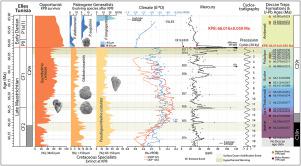当前位置:
X-MOL 学术
›
Glob. Planet. Change
›
论文详情
Our official English website, www.x-mol.net, welcomes your feedback! (Note: you will need to create a separate account there.)
Mercury linked to Deccan Traps volcanism, climate change and the end-cretaceous mass extinction
Global and Planetary Change ( IF 3.9 ) Pub Date : 2020-11-01 , DOI: 10.1016/j.gloplacha.2020.103312 Gerta Keller , Paula Mateo , Johannes Monkenbusch , Nicolas Thibault , Jahnavi Punekar , Jorge E. Spangenberg , Sigal Abramovich , Sarit Ashckenazi-Polivoda , Blair Schoene , Michael P. Eddy , Kyle M. Samperton , Syed F.R. Khadri , Thierry Adatte
Global and Planetary Change ( IF 3.9 ) Pub Date : 2020-11-01 , DOI: 10.1016/j.gloplacha.2020.103312 Gerta Keller , Paula Mateo , Johannes Monkenbusch , Nicolas Thibault , Jahnavi Punekar , Jorge E. Spangenberg , Sigal Abramovich , Sarit Ashckenazi-Polivoda , Blair Schoene , Michael P. Eddy , Kyle M. Samperton , Syed F.R. Khadri , Thierry Adatte

|
Abstract Mercury (Hg) anomalies linked to Large Igneous Provinces (LIP) volcanism have been identified in sediments across all five major mass extinctions in Earth's history. This study tests whether Hg in marine sediments is a reliable proxy linking Deccan Traps volcanic eruptions to late Maastrichtian global climate warming and the mass extinction at the Cretaceous-Paleogene boundary (KPB). Our primary test site is the Elles section in Tunisia, the auxiliary Global Stratotype Section and Point (GSSP) to El Kef. Elles has the most complete marine sedimentary record and a high average sedimentation rate of ~4.7 cm/ky. We chose the Hor Hahar section in Israel to corroborate the geographic distribution of Hg fallout from Deccan volcanism. Reliability of the Hg proxy over the last 550 ky of the Maastrichtian to early Danian was evaluated based on high-resolution age control (orbital cyclostratigraphy), stable isotope climate record, Hg concentrations, biotic turnover and mass extinction. These results were correlated with the pulsed Deccan eruptive history constrained previously by U-Pb zircon geochronology. Our results support Hg as robust proxy for Deccan volcanism with large Hg spikes marking “extreme event” (EE) pulsed eruptions correlative with climate warming peaks separated by steady, less intense eruptions. Long-term global climate warming began near ~350 ky pre-KPB, reached maximum warming (3–4 °C) between 285 and 200 ky pre-KPB, followed by gradual cooling and rapid temperature drop between 45 and 25 ky pre-KPB. During the last 25 ky before the KPB, multiple Hg EE eruptions correlate with hyperthermal warming that culminated in the rapid mass extinction at Elles during ≤1000 years of the Cretaceous. These latest Cretaceous Hg peaks may correlate with massive, distal, Deccan-sourced lava flows (>1000 km long) that traversed the Indian subcontinent and flowed into the Bay of Bengal, bracketing the mass extinction. These results support Deccan volcanism as a primary driver of the end-Cretaceous mass extinction.
中文翻译:

汞与德干火山活动、气候变化和白垩纪末大灭绝有关
摘要 在地球历史上所有五次大灭绝的沉积物中都发现了与大型火成岩省 (LIP) 火山活动相关的汞 (Hg) 异常。这项研究测试了海洋沉积物中的汞是否是将德干圈闭火山喷发与马斯特里赫特晚期全球气候变暖和白垩纪-古近纪边界 (KPB) 的大规模灭绝联系起来的可靠代表。我们的主要测试地点是突尼斯的 Elles 部分,是 El Kef 的辅助全球层型部分和点 (GSSP)。Elles拥有最完整的海洋沉积记录,平均沉积速率高达~4.7 cm/ky。我们选择了以色列的 Hor Hahar 部分来证实德干火山活动产生的汞沉降的地理分布。基于高分辨率年龄控制(轨道循环地层学)、稳定同位素气候记录、汞浓度、生物周转和大规模灭绝,评估了马斯特里赫特到大年早期最后 550 ky 汞代理的可靠性。这些结果与之前受 U-Pb 锆石年代学限制的脉冲德干火山喷发历史相关。我们的结果支持 Hg 作为德干火山活动的有力代表,具有大的 Hg 峰值标记“极端事件”(EE)脉冲式喷发,与由稳定、不那么强烈的喷发分隔的气候变暖峰值相关。长期全球气候变暖在 KPB 前约 350 ky 附近开始,在 KPB 前 285 至 200 ky 之间达到最大升温(3–4 °C),随后在 45 至 25 ky 前 KPB 之间逐渐降温和快速降温. 在 KPB 之前的最后 25 ky 期间,多次 Hg EE 喷发与高温变暖相关,在白垩纪 ≤ 1000 年内导致 Elles 的快速大规模灭绝。这些最新的白垩纪汞峰可能与大规模、远端、德干来源的熔岩流(> 1000 公里长)有关,这些熔岩流穿过印度次大陆并流入孟加拉湾,导致大规模灭绝。这些结果支持德干火山活动是白垩纪末大灭绝的主要驱动因素。
更新日期:2020-11-01
中文翻译:

汞与德干火山活动、气候变化和白垩纪末大灭绝有关
摘要 在地球历史上所有五次大灭绝的沉积物中都发现了与大型火成岩省 (LIP) 火山活动相关的汞 (Hg) 异常。这项研究测试了海洋沉积物中的汞是否是将德干圈闭火山喷发与马斯特里赫特晚期全球气候变暖和白垩纪-古近纪边界 (KPB) 的大规模灭绝联系起来的可靠代表。我们的主要测试地点是突尼斯的 Elles 部分,是 El Kef 的辅助全球层型部分和点 (GSSP)。Elles拥有最完整的海洋沉积记录,平均沉积速率高达~4.7 cm/ky。我们选择了以色列的 Hor Hahar 部分来证实德干火山活动产生的汞沉降的地理分布。基于高分辨率年龄控制(轨道循环地层学)、稳定同位素气候记录、汞浓度、生物周转和大规模灭绝,评估了马斯特里赫特到大年早期最后 550 ky 汞代理的可靠性。这些结果与之前受 U-Pb 锆石年代学限制的脉冲德干火山喷发历史相关。我们的结果支持 Hg 作为德干火山活动的有力代表,具有大的 Hg 峰值标记“极端事件”(EE)脉冲式喷发,与由稳定、不那么强烈的喷发分隔的气候变暖峰值相关。长期全球气候变暖在 KPB 前约 350 ky 附近开始,在 KPB 前 285 至 200 ky 之间达到最大升温(3–4 °C),随后在 45 至 25 ky 前 KPB 之间逐渐降温和快速降温. 在 KPB 之前的最后 25 ky 期间,多次 Hg EE 喷发与高温变暖相关,在白垩纪 ≤ 1000 年内导致 Elles 的快速大规模灭绝。这些最新的白垩纪汞峰可能与大规模、远端、德干来源的熔岩流(> 1000 公里长)有关,这些熔岩流穿过印度次大陆并流入孟加拉湾,导致大规模灭绝。这些结果支持德干火山活动是白垩纪末大灭绝的主要驱动因素。


























 京公网安备 11010802027423号
京公网安备 11010802027423号